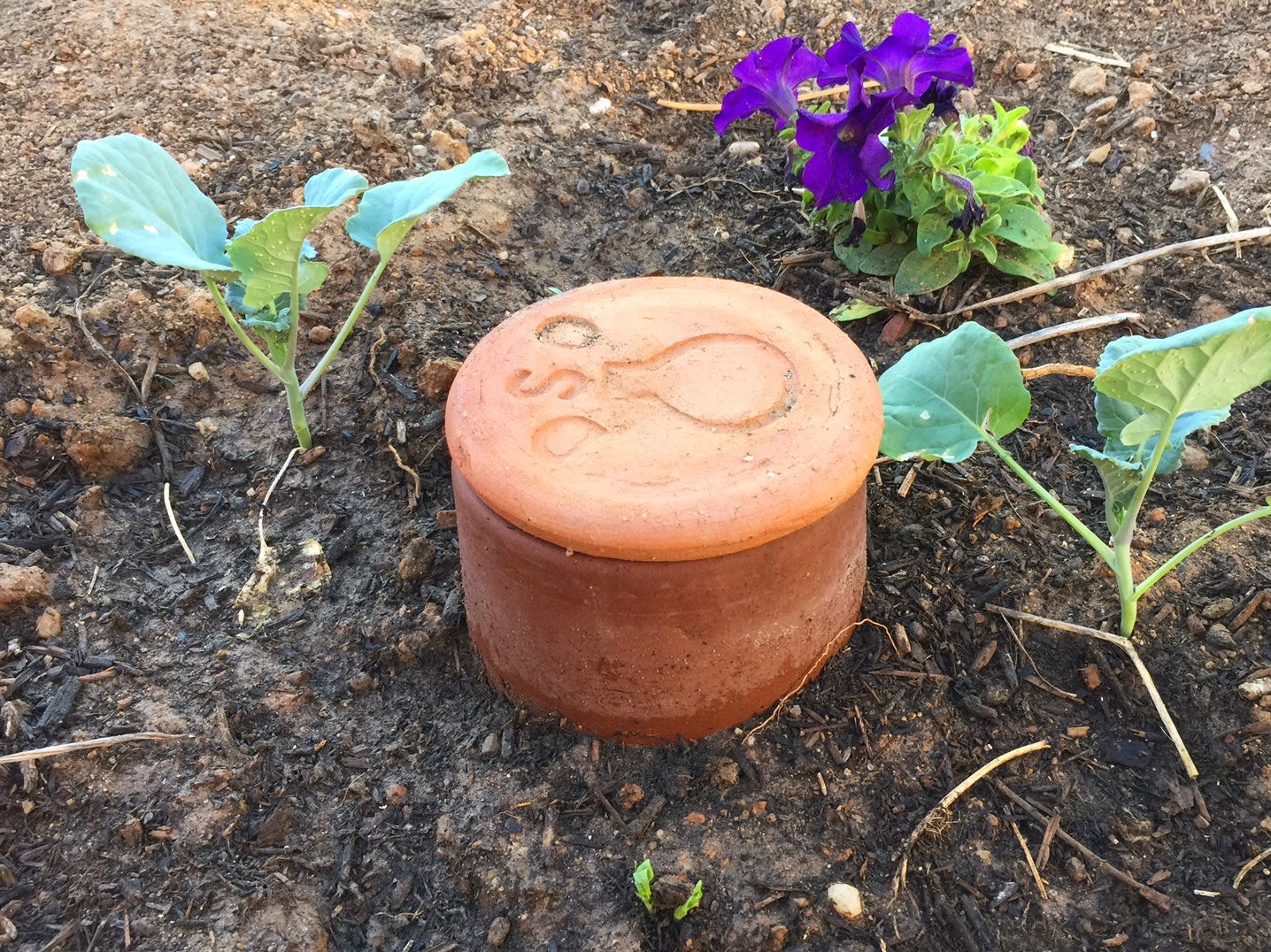The Proud Gardener
This time, the whole patch is fully integrated with the same type of soil instead of having abrupt shifts in soil types. (No more bobbing ollas!) Then, we buried the ollas and got planting. Here's the plan we used for our planting. First, we started with five (somewhat) evenly spaced ollas. (In the diagrams, one square = one square foot.)
Our plan started with big plants (broccoli and an artichoke) clustered around the ollas. (When we went to the nursery, I found some cauliflower plants that I just had to have, so a couple of those broccoli plants in the picture turned into cauliflowers instead. You know how it goes.)
Next, we added some medium size plants (lettuce, herbs) around the big plants. (We mostly planted these from seed.) When the cold weather hits, these should be protected by the leaves to the big plants. (That's the theory anyway!):
Next up: Nitrogen fixers (peas and fenugreek, also from seed). These are scattered throughout:
Last up, we scattered a few flowers throughout to make things pretty. The youngest garden girl got to pick the flowers (of course). She picked snap dragons and petunias:
The hardest things about making this plan was leaving enough room to reach the ollas to add water. It's easy enough now, but when the plants get bigger, it could get challenging. We'll see!
What do you think? 3 months from now, will I be able to see the ollas at all?
Right now, it's a mix of nursery plants and seeds. So I'm filling up the ollas to water the seedlings, plus using a watering can for the seeds. Once the seeds sprout and develop some roots, I'll be able to switch to watering just the ollas.
Can you see the little seedlings up front? Or is it like playing where's Waldo?
Want to learn more about ollas? Maybe from someone a little more trustworthy who seems to have some actual experience? Ha! The best information I have found is the FAQ section of the Dripping Springs Ollas site.
This Week's Permaculture Principles:
What?!? Am I still on that permaculture kick? Why yes, yes I am! And here are a few permaculture principles that influenced my little olla plan above:Observe and interact. I first grew broccoli in my garden a couple of years ago. I had the plants all lined up in tidy little rows on a drip irrigation system. I also had a few spinach plants crammed into the same raised bed because I was low on space. That year, we had a lot of cold weather. When the first frost hit, I panicked a bit when my broccoli plants got all droopy, posted pictures of the broccoli on the Tucson Backyard Gardener's Facebook group, and asked if there was any hope. The smart people there told me it would be fine (it was) and also mentioned what a nice job the broccoli had done of shielding the spinach from the frost too. So I've learned my lesson. Broccoli withstands frost well and is good at shielding other plants from it.
 Use small and slow solutions. I am in love with the idea of ollas, but as much as I want to, ripping out all my drip irrigation and replacing it all with ollas probably isn't smart. I just don't know enough about ollas yet to know that I can make it work. So I started my experiments with ollas this summer with just two (one "real deal" and one DIY version). Convinced I could make the "real deal" work, I have now branched out with five. Assuming I can make five work, maybe next spring I'll get more ollas. I'll keep building up slowly until I get to the right amount.
Use small and slow solutions. I am in love with the idea of ollas, but as much as I want to, ripping out all my drip irrigation and replacing it all with ollas probably isn't smart. I just don't know enough about ollas yet to know that I can make it work. So I started my experiments with ollas this summer with just two (one "real deal" and one DIY version). Convinced I could make the "real deal" work, I have now branched out with five. Assuming I can make five work, maybe next spring I'll get more ollas. I'll keep building up slowly until I get to the right amount.Integrate rather than segregate. As you've probably noticed, my little plan is all about integration. (Or as my husband says, "It's going to look like a big mess, but in a good way.") I've packed as many different plants and purposes around five little ollas as I possibly can. Chances are some of them won't do so well. (For instance, I haven't traditionally had a lot of luck with peas, although I am trying a different type that's more suited to this climate this time.) But by including so many different types of plants in there, not only are some of them bound to succeed, hopefully, they will also help each other out.










No comments:
Post a Comment